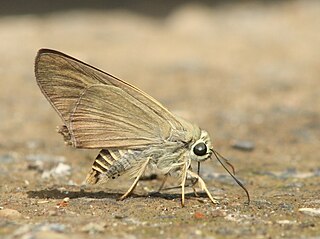
Badamia exclamationis, commonly known as the brown awl or narrow-winged awl, is a butterfly belonging to the family Hesperiidae. It is found in south and southeast Asia, Australia, and Oceania.

Burara jaina, the orange awlet, is a species of hesperid butterfly found in Asia. The butterfly was reassigned to the genus Burara by Vane-Wright and de Jong (2003), and is considered Burara jaina by them.
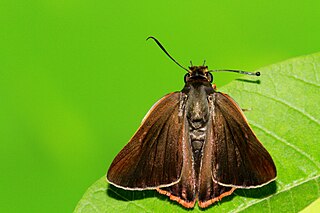
Bibasis sena, commonly known as the orange-tailed awlet, is a butterfly belonging to the family Hesperiidae, the skippers. It is also sometimes called the pale green awlet though that name can also refer to Bibasis gomata.

Choaspes benjaminii, also known as the Indian awlking or common awlking, is a species of butterfly in the family Hesperiidae. The species is named after Benjamin Delessert and was described on the basis of a specimen collected by Adolphe Delessert in the Nilgiris.

Hasora badra, the common awl, is a butterfly belonging to the family Hesperiidae, which is found in India.

Aeromachus dubius, the dingy scrub-hopper, is a butterfly belonging to the family Hesperiidae. It ranges from India to China, including Malaya, Assam, Myanmar, Laos, Vietnam, Hainan and Yunnan.
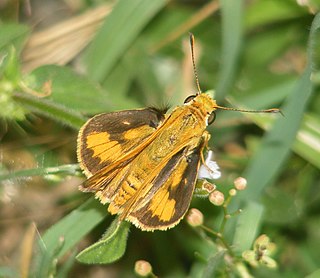
Telicota colon, commonly known as the pale palm dart or common palm dart, is a species of butterfly in the family Hesperiidae. It is found from India to Australia.

Danielpalianosist, commonly known as the common spotted flat, is a species of butterfly belonging to the family Hesperiidae. It is a common butterfly generally found in the wet forested hills of southern Asia, from India and the Himalayas east through Indo-China. The upper surfaces of the wings are dark brown with white bands and small white spots towards the tip of the wings.
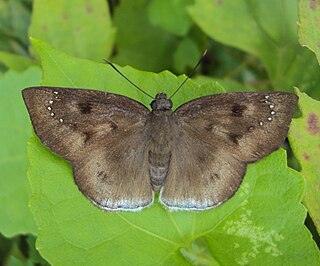
Tagiades gana, the immaculate snow flat, large snow flat or suffused snow flat, is a butterfly belonging to the family Hesperiidae found in Indomalayan realm.

Appias indra, the plain puffin, is a small butterfly of the family Pieridae, that is, the yellows and whites, which is found in south and southeast Asia.
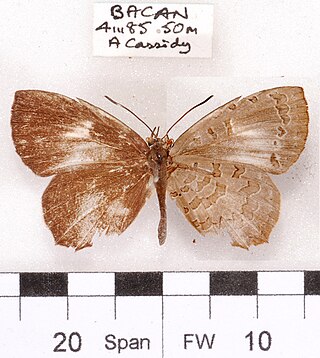
Miletus boisduvali, the common brownie, is a small but striking butterfly found in India and Myanmar that belongs to the lycaenids or blues family.

Bindahara phocides, the plane, is a small butterfly found Indomalayan and Australasian realms that belongs to the lycaenids or blues family.

Chilades parrhasius, the small Cupid, is a small butterfly that belongs to the lycaenids or blues family. It is found in Nepal, southern Turan, southern Ghissar, Iran, Afghanistan, Pakistan, Sri Lanka, United Arab Emirates, Oman and southern, central and north-west India.

Acytolepis puspa, the common hedge blue, is a small butterfly found in Cambodia, India, Myanmar, Thailand, Malaysia, Singapur, Yunnan, Taiwan, Sri Lanka, Philippines, Borneo and New Guinea that belongs to the lycaenids or blues family. The species was first described by Thomas Horsfield in 1828.

Plebejus christophi, the small jewel blue, is a small butterfly found in Asia that belongs to the lycaenids or blues family.

Bibasis anadi, the plain orange awlet, is a species of hesperid butterfly found in India and Southeast Asia. The butterfly has been reassigned by Vane-Wright and de Jong (2003) to the genus Burara and is considered by them Burara anadi.

Hasora anura, the slate awl, is a species of hesperid butterfly found in Asia. In India it is found in Sikkim and the Khasi Hills.

Pamiria omphisa, the dusky green underwing, is a species of blue (Lycaenidae) butterfly found in Asia.

Actinor is a Himalayan genus of butterflies in the family Hesperiidae. It is monotypic, being represented by the single species Actinor radians, the veined dart.

Celaenorrhinus putra, commonly known as the Bengal spotted flat, is a species of butterfly in the family Hesperiidae. It is found in India and south-east Asia.




















